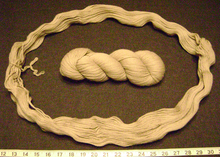Strand (textile)
The strand , the strands , the strand or Fast consists of a limited length of yarn , which is spirally wound over one another in the form of a multi-layer ribbons. The usual circumference of strands or strands is between 1 meter and 2 meters.
General
The winding of a strand is usually done with the help of a reel ; a yarn winch is required for unwinding . In order to secure the strand from falling apart, it is tied at at least one point, usually several times. In contrast to the ball, every section of the thread bundle is visible and can thus be checked for material thickness and defects. In the dye works , the textile dye can act in every area of the thread.
For storage and transport, the strands are twisted into a so-called dock or mastiff .
Merchandise
Certain weaving yarns, in particular made of wool, but especially embroidery yarns, are commercially available as skeins. Hand-weaving threads are mostly made in 100 g strands, embroidery threads in very small docks of 10 g.
Unit of measurement
A measure of yarn count that is still widely used in the textile industry and textile craft and uses the skein as the basic unit is the English numbering for cotton, abbreviation NeB. This is based on a hank in which the thread was wound 560 times around a reel with a circumference of 1.37 meters (1.5 yards ), and the thread length is therefore 768 meters (840 yards ) amounts. The NeB yarn number then indicates how many such strands weigh 453.6 grams (1 pound). NeB 20 z. B. means that 20 strands are required to achieve this weight. The yarn of a number NeB 20 is twice as fine as yarn with NeB 10, which applies the same weight with already 10 strands.
See also
literature
- Erika Arndt: Weaving manual. History, materials and techniques of hand weaving. Bern 2006, ISBN 3-258-06993-X .

